Mars Hydro finally joined the fun.
They jumped on the quantum board and bar light bandwagons (who hasn’t at this point?) and released several full-spectrum white LED grow lights.
In fact, they released four lines of lights: the SP series, TS series, FC series, and FC-E series.
Two are bar style lights and two are quantum board style lights.
What’s the difference between them?
Not much. They are very similar, but they do have a few key differences, which I’ll cover below.
The important thing is that all use mostly full-spectrum white LED diodes, with a mix of cool white and warm white.
They supplement that white light with additional red and IR diodes. The SP series also adds in UV light.
This mix of light gives them a spectrum that is very similar to the HLG quantum board lights or to COB LEDs, with additional red. It is the perfect spectrum for plants and the biggest strength of Mars Hydro’s newest fixtures.
Let’s take a look at a comparison of the four series, before we get into a more in-depth review of each one.
Mars Hydro Review: FC, FC-E, TS & SP Series Comparison
- Max Yield: 2.5 g/w
- Efficiency: 2.74-2.82 umol/j
- Max Yield: 2.3 g/w
- Efficiency: 2.6 umol/j
- Max Yield: 3 g/w
- Efficiency: 2.85 umol/j
- Max Yield: 2.5 g/w
- Efficiency: 2.8 umol/j
Mars Hydro SP 3000 Review
This review focuses on the Mars Hydro SP 3000 (updated version of the SP250), but everything written here goes for the SP 150 and SP 6500 as well, apart from the individual specifications.
- Uses 300 watts — save about 50% on your electric bill over HID lights
- Equivalent to a 400 watt HID system — but costs less to buy AND to operate
- Ideal spectrum for plants — the perfect light for all stages of growth, with peaks on red and blue and a lot of light in every other color, plus UV and IR
- Highly efficient — great output from a low power usage (2.8 μmol/J)
- 2 by 4 foot core coverage — the coverage for vegging is a bit larger at 3 by 5 feet
- Samsung LM301B diodes — best on the market and highly efficient
- Dimmable Driver — made by Meanwell, the industry standard driver; it is dimmable and can be removed from the fixture and placed outside your grow tent to keep heat down
- Rated for 50,000 hours — 4-5 years with no bulb changes
- 5 year warranty — and a 30 day money back guarantee
Advantages
The three strongest points of the Mars Hydro SP Series are the color spectrum, the high output per watt consumed and the low cost.
Let’s begin with the spectrum. The industry is finally moving away from the blurple color spectrum and moving to spectra that contain at least some white diodes. Many lights have mostly white, and some use nothing but white.
I am so happy to see Mars Hydro join the “white light revolution”.
They do so using white SMD diodes from Epistar on the 150 and from Samsung on the 3000, which makes them very similar to the quantum board lights.
But Mars actually went one better, by adding IR and UV diodes to round out the spectrum in the areas where all-white LEDs fall a bit short. In the SP 3000, they also added red diodes. The addition of red, IR and UV is similar to what the top COB lights do.
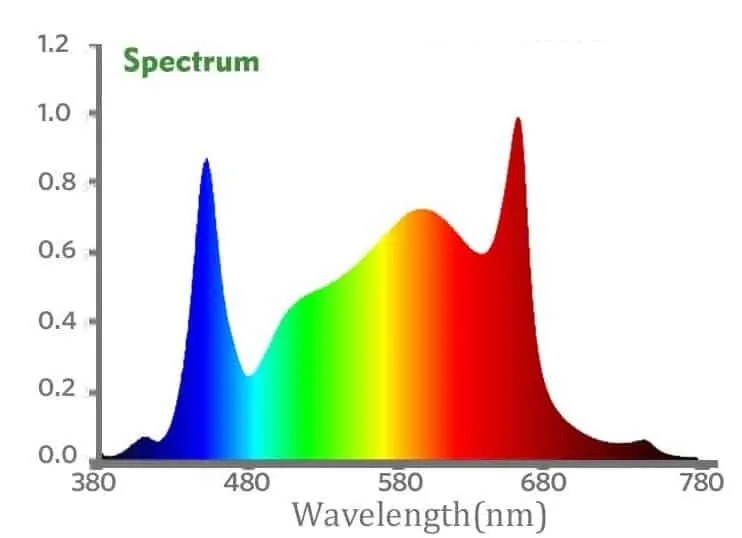
Basically, Mars uses the quantum board spectrum, but fixes that spectrum’s biggest weaknesses: the lack of UV and IR. Plus they add some red light to the SP 3000 for good measure.
The end result is the perfect spectrum for every stage of growth. It is very similar to natural sunlight, with added red and blue light, since those are the colors of light plants need the most.
The Samsung LM301B diodes are driven by a MeanWell dimmable driver. It drives them at around 300 watts at full power and is highly efficient (2.8μmol/J), giving you an output equivalent to a 400 watt HID system.
Specifically, it achieves a PPFD of 999 umol/m²/s dead center at 19.5 inches from the canopy, which is how high you would hang the light during bloom, for a 2 by 4 foot coverage area.
During the vegetative stage, you would either hang it 24 to 30 inches, which increases the coverage to 3 by 5 feet, or you would simply dim the light down a bit and save on power costs.
I have included the PAR footprint provided by Mars Hydro (at a 19.5 inch hanging height), so you can see some of the PPFD numbers as you move away from the center.
Apart from that, the long rectangular form factor of the two SP series lights is a big advantage to some. If you have a small, square grow tent, it probably won’t work for you. That’s where the TS series comes in (see below).
But if you have a larger operation, with several rows of plants (perhaps even stacked vertically), the long form factor can be a huge advantage.
It allows you to install the long lights directly above each row of plants and not waste light by lighting the aisles, as square lights often end up doing, because their coverage is wider than a row of plants.
The large size of the fixtures has another major advantage. It gives you a more even coverage. A smaller fixture emits light from a smaller point. The light then spreads outward. It has to travel further to get to the corners of the coverage area, which means the light is much less intense in the corners.
A larger fixture means the light does not travel as far to reach the outsides of the coverage area, so the light does not lose as much intensity. This results in smaller PPFD readings in the middle, but higher ones around the outside. In other words, a more even coverage.
In the past, customer service was always a huge disadvantage of Mars Hydro (as with most Chinese manufacturers), but now that they have service centers in the US, it is much easier to get help, if you need it.
That’s why this is now an advantage, especially when compared with other budget lights.
And to add to that, Mars now gives you a 3 year warranty and they let you return the light for a full refund within 30 days of your purchase (that is obviously not enough time to try out the light for a full grow, but you can at least test it and see that it is as powerful as advertised).
Disadvantages
As just mentioned, the long form factor could be a disadvantage, if you have a square tent, or one that is too small for one of these long lights.
Apart from that, probably the biggest disadvantage of the SP series of lights is the heat output. They use only heat sinks, with no fans whatsoever. This means a silent operation, but it also means that the lights can get pretty hot.
If you are growing in an enclosed space, you’ll probably have to include some extra ventilation for these lights. Not as much as you’d need for an HID system, but definitely more than you’d need for a similarly powered LED grow light.
Mars Hydro SP Series LED Grow Light Review: Final Verdict
The Mars Hydro SP 3000 LED Grow Light and its little brother, the SP 150, are a great addition to Mars’ lineup. More than that, they are easily the best lights in that lineup (along with the TS series reviewed below).
They give you a color spectrum similar to the quantum boards, but add in IR and UV light. In the case of the 300, they also add more red light. This gives them a very similar spectrum to the top COB grow light manufacturers on the market (Amare and Optic), as well as Green Sunshine Company.
But at a much lower cost.
The only lights that can compete on price are the Spider Farm SF LED grow lights reviewed here. They are perhaps a somewhat more reliable company than Mars, but they do not have UV diodes.
Note that Mars only Samsung diodes and Meanwell drivers on the SP3000 and SP6500. The SP150 used Epistar diodes and an ETL driver.
And now that Mars Hydro has service centers in the US, you don’t have to worry about dealing with a huge hassle to get your light repaired or replaced if something goes wrong. Help is much easier to come by than it used to be.
Given the high efficiency and ideal spectrum of this light, and the great price, it gets a rating of 4.7 out of 5.
Mars Hydro TSW 2000 Review
- Uses 300 watts — save about 50% on your electric bill over HID lights
- Equivalent to 500 HID watts — but costs less to operate
- Ideal spectrum for plants — the perfect light for all stages of growth, with peaks on red and blue and a lot of light in every other color
- Highly efficient — great output from a low power usage (2.6 μmol/J)
- 3 by 3 foot core coverage — the coverage for vegging is a bit larger at 4 by 4 feet
- Epistar diodes — not the best on the market, but very good and keeps costs down
- Dimmable Driver — can be removed from the unit and placed outside your grow tent to keep heat down
- Rated for 50,000 hours — 4-5 years with no bulb changes
- 5 year warranty — and a 30 day money back guarantee
The TS series has four lights: the 600 is the smallest, the 3000 is the largest and the TS 1000, TSW 2000 and TSL 2000 are in the middle and about the same, differing mainly in their form factor.
The TSW is almost square and gives you a square coverage area, while the TSL is long and gives you a rectangular coverage area similar to the SP series of lights.
This review focuses on the Mars Hydro TSW 2000, but everything written here goes for the other three lights as well, apart from the individual specifications.
Advantages
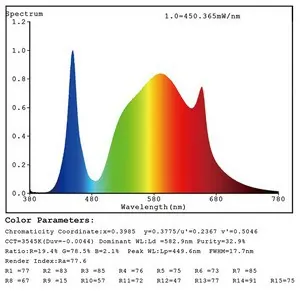
As with the SP lights, the TS lights have a great spectrum for any stage of growth. But their spectrum is a little different than the SP spectrum.
The TS lights do not have any UV. That’s not a huge deal, to be honest, but may matter to some.
The truth is, UV light may make a small difference in yield quality, but it has not yet been definitely proven.
That said, it is easy enough to just get a supplemental light that provides UV. Since UV light really only has an effect during the final few weeks of flowering, it may even be better to just get a cheap UV fluorescent bulb instead.
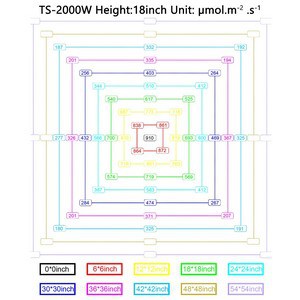
There’s always a trade-off. Lose UV, but gain power.
The other big difference is in the form factor. While the TSL 2000 has a similar form factor, and thus a similar application, to the SP series, the other three TS series lights look very different.
They are all square, which makes them well-suited for use in a square grow tent or growing area. They are still large lights, so you get the same benefit in terms of even coverage. It’s just that the coverage area is square instead of rectangular.
Disadvantages
While the SP series is appropriately named (i.e. the SP 250 uses about 250 watts), Mars Hydro is back to their old tricks in naming the TS lights. Sure, they do not say “1000w” or “2000w”, but naming these lights the “1000” or the “2000” gives the impression that they are referring to wattage.
And they know that full well.
To be fair, it is not only Mars Hydro that does this. Most manufacturers do it, especially the Chinese ones, who do it more blatantly than the rest.
Because of that, not misnaming your lights will actually cost you sales, because the average consumer simply is not very well informed. Just look at the perception Black Dog has, because they name their lights honestly.
But just because everyone does it, that does not make it right. That’s why I will always list this under the disadvantages of a light, even if I don’t really take it into account in the ratings (how could I, if just about everyone does it?), unless it is especially egregious (I’m looking at you Roleadro/Galaxyhydro).
Most of the TS series does not make use of Meanwell drivers, like the SP series. The exception is the 3000, which uses two of them. It is a shame that the other TS lights don’t, because the Meanwell drivers are better quality than the Chinese branded ones on the TS series lights. They still work well, though and they are also dimmable.
Apart from that, the only other disadvantage that the TS series has and the SP does not is the lack of UV. But, as mentioned above, not using space for those means more space for the more powerful white diodes, so this is not necessarily a disadvantage. It just depends on your needs.
Mars Hydro TS Series Review: Final Verdict
The Mars Hydro TS 2000 full-spectrum white LED grow light is one of the best lights on the market and the same goes for the other three TS lights. The TS and SP series are, without a doubt, the best lights made by Mars Hydro, by far.
Yes, they cost a bit more than other Mars lights, but the difference is well worth it. If you compare the cost to the quantum lights, like HLG and NextLight, these are far cheaper. And they actually have a better spectrum!
That is why I give the TS series the same high rating as the SP series: a 4.7 out of 5.
Mars Hydro FC 4800 Review
The FC series has four lights: the FC 3000 is the smallest, the FC 8000 is the largest and the FC 4800 and FC 6500 in the middle. All four lights are bar style fixtures which is the style that is currently the most popular.
The advantages of the bar style lights is an even light distribution (though the quantum board lights have a more even coverage) and easier cooling, since air can flow between the bars.
The FC series uses high quality components, like Meanwell drivers and Samsung LM301b chips. If you want to save a bit of money, you can go with the FC-E series instead, which substitutes cheaper Bridgelux chips and ETL drivers.
This review focuses on the Mars Hydro FC 4800, but everything written here goes for the other three lights as well, apart from the individual specifications and the fact that the FC 4800 and FC 6500 are foldable.
Mars Hydro FC Series Review: Final Verdict
The Mars Hydro FC Series is a great addition to the bar light market. It sells for a lower cost than brands like Optic and Grower’s Choice (both of which are American brands, but manufacture in China and have horrendous customer service), but has the same, or better, quality components.
I would get Mars Hydro over any other brand that makes bar lights, except for Spider Farmer and perhaps Viparspectra. Several friends of mine have had issues with Mars Hydro in the past. And while they claim their customer service and quality control is much improved, they’ve made that claim before and it turned out ot to be true.
If you receive a great light, everything is great. But if you receive a dud, things can get messy. That said, there is not all that much difference between their bar light and those of competing brands (they are probably even all made int he same factories in China). IT just comes down to which brand you prefer or which one currently ha a better sale going.
Personally, I prefer Spider Farmer first, and then Viparspectra second. That’s why the Mars Hydro FC series gets a rating of: a 4.7 out of 5.
Mars Hydro FC-E4800 Review
The FC-E series has three lights: the FC 3000 is the smallest, the FC 6500 is the largest and the FC 4800 sits in the middle. All three lights are bar style fixtures, just like the FC series we just looked at.
So what is the difference?
The first, and most obvious, difference is the price. The FC-E series costs less that the equivalent FC series lights. And the reason for this is simply: cheaper components.
Where the FC series uses Meanwell drivers and Samsung chips, the FC-E series uses Bridgelux chips and Mars Hydro drivers. The lights are also not foldable.
Let’s take a quick closer look at the Mars Hydro FC-E4800. Everything written here goes for the other two lights as well, apart from the individual specifications.
Mars Hydro FC-E Series Review: Final Verdict
The Mars Hydro FC-E series is almost identical to the FC series, except it costs less and uses lower quality components. They are still excellent, but they’re not top of the line. That is why I give the FC-E series a slightly lower rating than the FC series: a 4.5 out of 5.
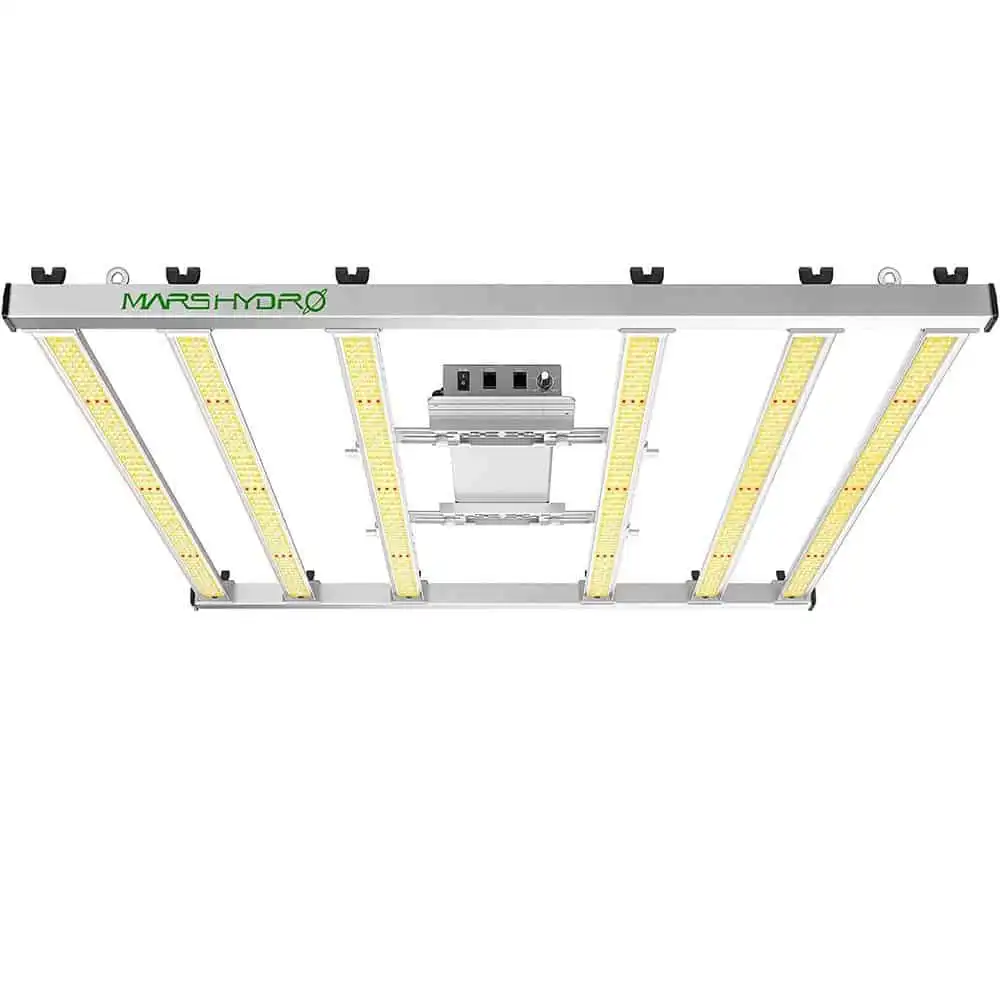
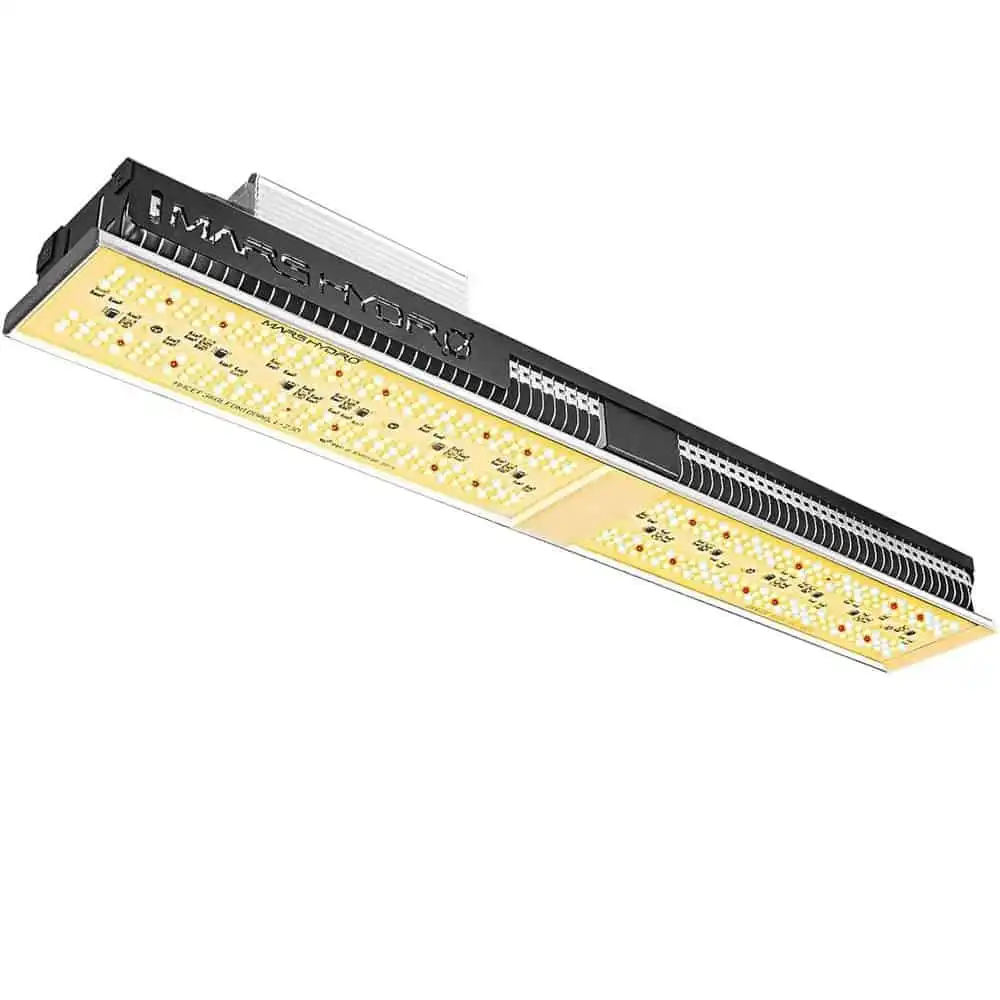
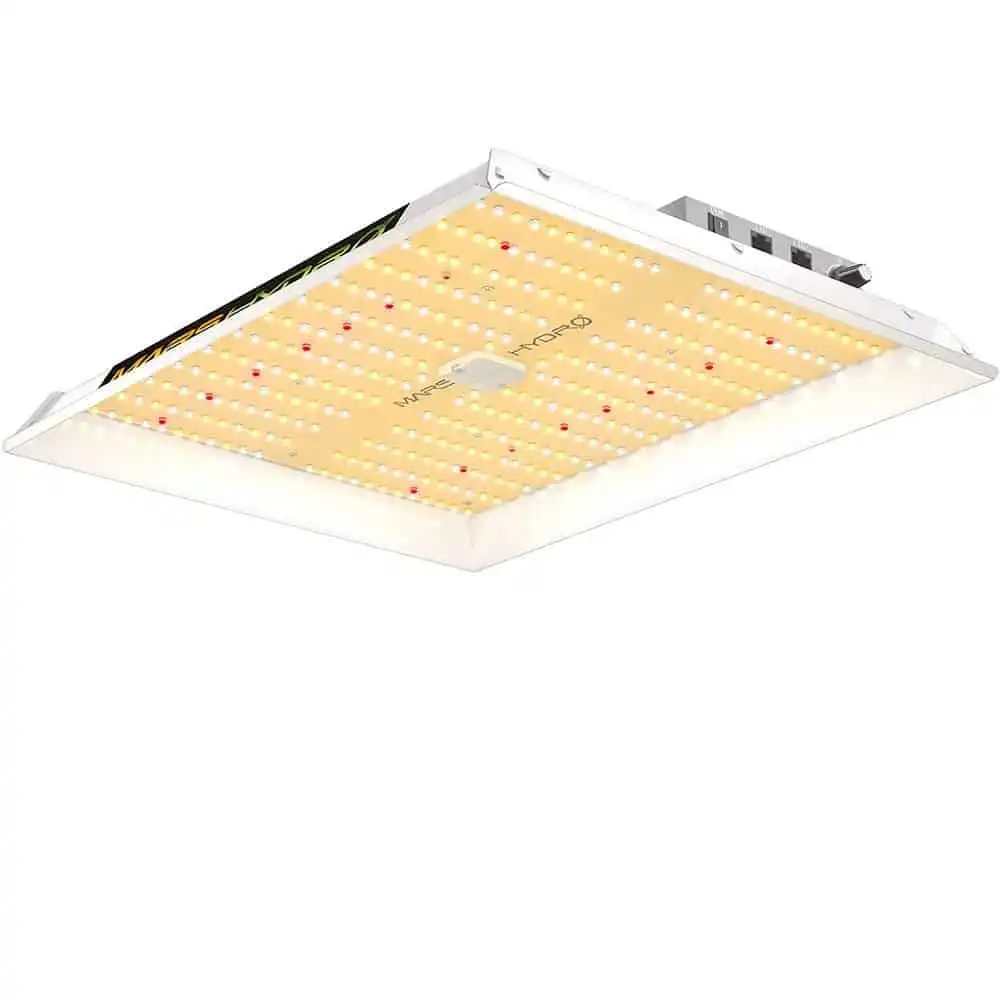
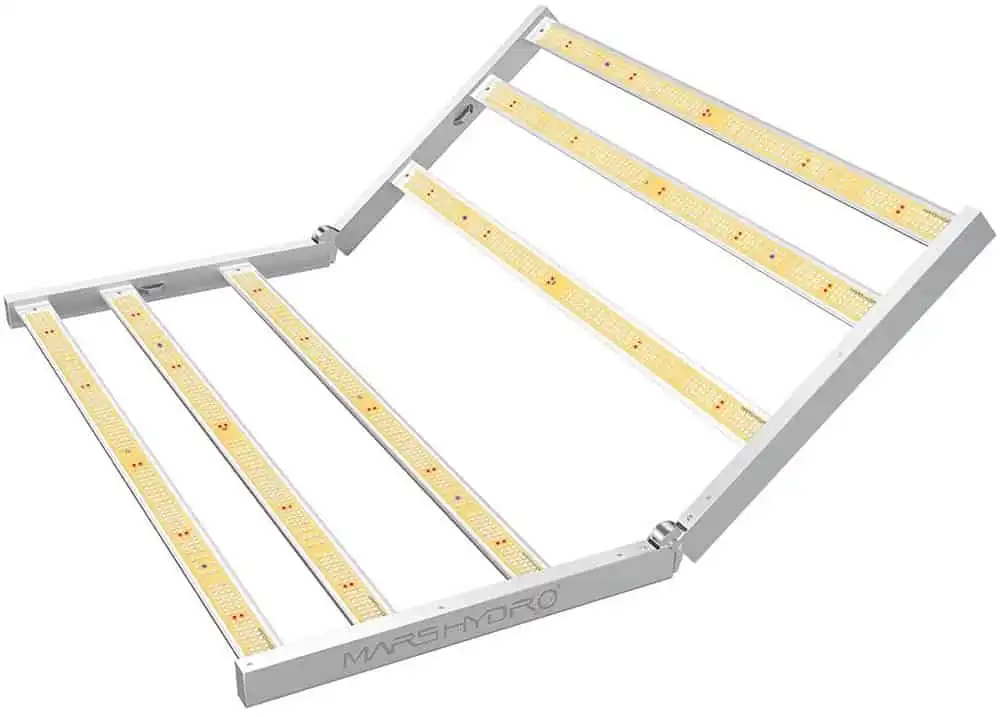
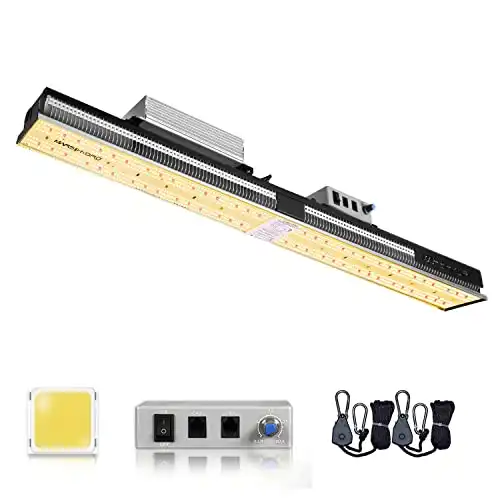
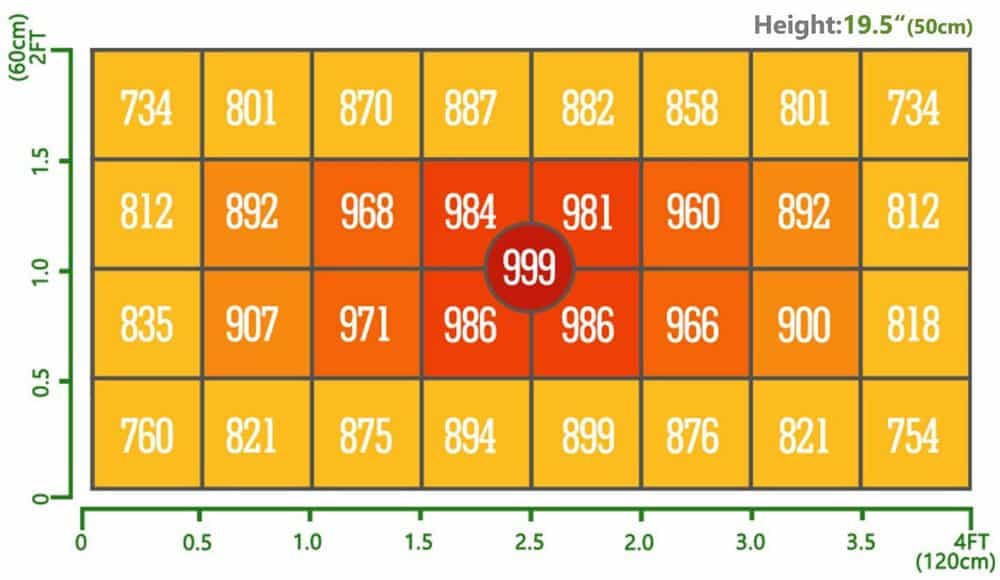
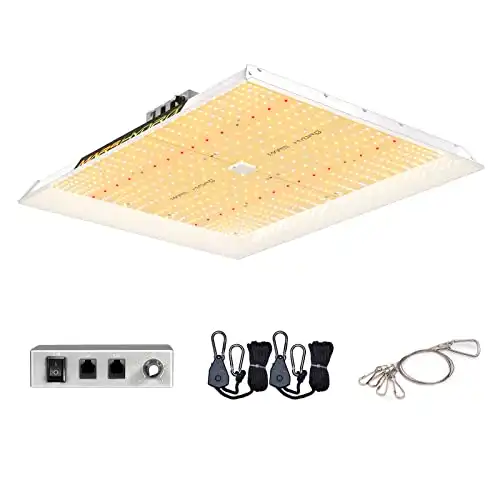
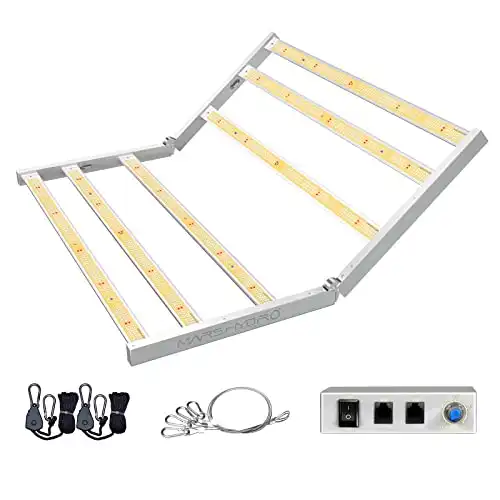
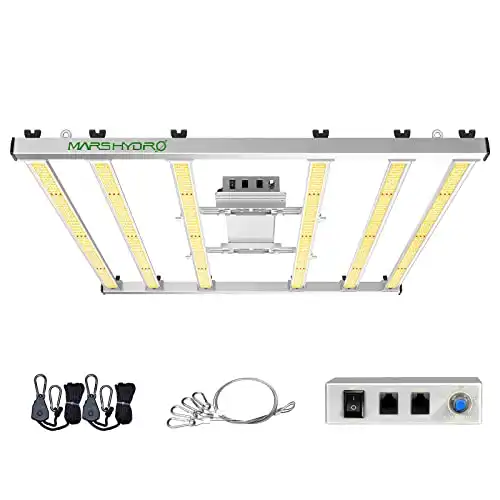
I’m curious about the differences that the UV and the IR provide. I recently picked up TSW 2000 for my Colocasias and Alocasias (Elephant ears) and I’m wondering if I should bring it back back for the upgrade.
The jury is still out on that. Either way, I don’t think the difference is THAT huge. You can always just get a separate UV bulb.
Why has the PAR measurement for the TS1000 been taken at 18 inches whereas all the others are taken at 12 inches.
Pete
Bs
It has been changed. They are all at 18 inches now.
Hello I have a tsw 2000 I was wondering if you know I have mine set on a timer 18-6 and I’m wandering why why the time goes off its meant go off but I think but when I have a look the light is not completely off just dimmed like it’s sleep mode or something can you please help
Where did you get the information that the Mars Hydro TSW2000 (and the TS 1000?) use the Meanwell driver? I was under the impression from other reviews that these lights use a generic Chinese driver. Also, I don’t think the Mars Hydro website mentions the Meanwell driver on these models. I hope I am wrong, so let me know if I am. Thanks
They have photos of the drivers on their website.
For what it’s worth, a Mars Hydro rep responded to an email question from me and said that the driver on the TS1000 was Chinese.made. Hard to know which is correct.
Maybe they use fake photos. Wouldn’t surprise me at all. Or it’s a Meanwell knockoff.
They use meanwell on the SP boards and Chinese drovers on the TS series
3000 uses mean well. 1000 and 2000 do not.
Mars Ts3000 use MW driver and Samsung chip
I recently purchased the Philzon 3000 and I’m growing in a 4×4 tent. When I turn on the cob lights the temperature skyrockets to 90degrees plus and I lose all my humidity. I was thinking of purchasing the mars hydro 3000 instead seeing that it’s all LED lights in hopes that I can control the climate with more ease. What do you think ?
The Mars runs a bit cooler, but you’re going to need some kind of ventilation either way. Perhaps a humidifier, too.
i know you raved about the philzon 3000 watt cree cobb. would you prefer it over the mars hydro ts 3000 ?
Yes, I would prefer the Phlizon. If you’re looking for quantum boards style lights, I prefer Spider Farmer over Mars.
thanks, for taking the time to reply. 🙂
my spider farmer burn out and my mars hydro is still going strong and the crazy part is the same people make both lights do the research and see for yourself and look at all the reviews you will see 100 people say there spider farmer burned out like mine but you dont see that on mars hydro reviews most people will lie to you so you will buy other brand lights so watch people they get payed to do these things from grower to grower i hope this helps
The Mars Hydro sp250 does have a Mean Well Driver
The whole thing is quite confusing, but I think the answer is this: the SP series uses Meanwell drivers, while the TS series does not.
ah I see, sorry. I did contact Meanwell directly about it, because its obviously quite concerning that the power supply could be a cheap imitation. They got back to me today and told me how to verify the driver through their website using the serial number and mine is genuine. I will definitely be careful in the future though. thanks
The tsw 3000 has meanwell drivers
You’re right, it does. Hopefully they’ll switch them all over to Meanwell in the near future.
The tsw 3000 has meanwell drivers although there ts 1000 and 2000 model uses cheaper chinese design.
Quick irrelevant question for you guys. Currently im using a 4×8 low height tent . I have a ts 2000 and a cmh 315 phillips bulb.im wondering wheather it would be worth getting the 3000 model and getting rid of the cmh and use it in my veg tent. Or option 2 keep the ts 2000 and add another ts 2000 and put the smh lamp inbetween them.
Sorry for the extra long rant . Any advice would be greatly appreciated
Do you find that the 2000 is covering 4 feet adequately? If so, you can stick with it. But ideally, you’d want 2 of the 3000 for that space, assuming you have the vertical space in the tent for the more powerful light.
I converted from the Mars II 1600’s to the TS-3000’s….WOW what awesome lights! I loved my 1600’s but these quantums are beyond sweet. Now, I gotta point out…. you need to clarify your numbers a bit as you print that the TS-3000 draws 310 watts… it’s 450w. Also the SP series are waterproof. It is interesting to note that 2 TS-2000′ are 600w….to a single TS-3000’s 450…
Wonder what the yield difference would be in a side by side grow (yield) of a SP-250 and a TSL-2000???
The information looks correct. It says that the 3000 uses 450 watts.
The yields would probably be pretty similar between those two.
I am curious… Because a TS-3000 covers 4×4 at 450w…and the TSL-2000 cover half that @ 300w. So… shouldn’t the yield per watt number logically be higher for the smaller unit??? I mean 2 TSL’s should outperform 1 TS… going by the stated numbers.
I currently use the TS-3000 (grow room), the TS-1000 (mother plant room), the TS-600 (clone room)…and have a TSL-2000 (adding to grow room) on the way to add to my set up….should be interesting.
I also wonder how the grams/watt formula (which I don’t like, I prefer the more accurate kH/gram formula) is affected by having fans in the equation (my previous units had cooling fans….and cleay that is part of their energy usage but NOT going out in the form of light…so how do they calculate their grams per watt witchcraft? Are they using the ACTUAL wattage used…or the stated “HPS equivalent”??? Because there’s a huge difference…. 😐🎯
I have the TSL-2000 and this harvest was my very 1st grow of anything ever. I harvested 2 autoflower plants (one at 86 days and one at 95 days) and I pulled 272 grams of dry bud not including all the smaller buds and trim that I used to make hash. Even with all my mistakes I made I still pulled almost 1 gram per watt and without all my inexperience could have EASILY pulled alot more than that. The point is that for the money, Mars Hydro is one of the best lights you can buy
Whoever did this review saying that the TSL-2000 doesn’t have infrared lighting is INCORRECT! The TS line doesn’t have UV light but it DOES have infrared light. Anyone interested in buying the TS line needs to know that. It DOES have infrared just not ultraviolet light
True. It wasn’t the case when the review was written, but they have updated the lights, so the review needs to be updated as well.
bought 2 last week not bad lights but the price keeps rising due to the virus it still dont cost them any more as they all ready got them in stock so they taking the piss i was going to buy 4 more but due to there piss taking i will be changing suppliers and never buy mars again 1 lost customer samsung are on the same level as these lights but they dont exploit you or the price still the same as last week good bye mars
Part of it is also the trade war. Most companies have been avoiding raising their prices as much as possible and just eating the additional costs, but whenever you slap tariffs on something, it eventually trickles down to where we, the consumers, have to pay them.
With the added virus situation now, I think we’re going to see a lot of tariff-related price increases on Chinese products.
But for roughly the same price would it be better to buy 2 sp150’s or 1 ts2000?
Generally, I like more smaller lights better than fewer larger ones, but in this case, I’d base my decision on the UV light. If you want that, go with the SPs.
I just purchased two ts600 for my 36*36*72 grow tent , how many light should I use for it , notice I intend to grow up to 3 plants.
Thanks with regards
You’ll want 4 of those to fill that tent.
In a 1.2×1.2×2.0m tent would I be looking at a TSW2000 for full coverage and max yield?
You’d want the 3000 for maximium yield. Plus the 2000 would not quite fill that tent.
Hi Steven, thanks for the response.
I’ve had a look at the SF series instead, I assume an SF4000 would be best – however could I use a SF 2000 to kickstart things and purchase a second SF2000 to throw into the mix before switching to flowering?
Just trying to keep my initial outlay quite tight, I know the investment will pay off and am happy to spend additional on a second light in 2-3 weeks once payday comes around!
Yes, two 2000s are basically the same as one 4000. Having two smaller ones also gives you more flexibility than one larger one.
Hiya do i need a voltage regulator to use the ts 3000 or can I just plug it in and let it do its magic cheers
Just plug it in.
Trying to order tent and light today. I want the 60in x 32in tent and really want the SP3000 as the par readings are great. Or I could get the 2 x 4 tent which I know the SP3000 will be more than enough. I’m doing auto’s so my thought is 12.5 sqft is better than the 8 sqft for tent size. My other idea is get the larger tent but get 2 of either Mars TS 2000’s or even Maxsisun PB 2000’s(they use Sosen drivers and are cheaper). Also, having 2 lights is safer in case one goes out I’m not stuck like chuck. What do you think????? I’m just so torn I love that sp30000
I’d go with the two light option, for the exact reason you mentioned.
good write up… I was convinced I was going to buy the 3000w to replace my HPS1000 in my flower room but after seeing the SF 4000 I may have changed my mind. I have 2 MH 600w for veg and they love the light spectrum… I have 2 1000w HPS with an MH sp250 in between and there is zero difference in the yield from the leds in the middle…If anything the HPS gives more stretch. I am vacillating about making the dive from HPS because they have been proven battleships, but the expense of running them is getting old… I have 2 4×8 trays with same setups as described…. Thoughts?
If you want to switch to LED, I would go with two SF4000 lights for a 4×8 tray. Your yields will probably go down a bit, at least at first, but once you get used to the differences in growing with LED, they should be close.
It’s possible to induce blooming on photo period plants with this led ? How ?
Switch to a 12 hours on, 12 hours off lighting schedule.
What would you recommend for a 2’x4′ tent? SP150 or TS 1000? Would the SP be better simply based off its shape with the longer tent?
You’d want either the SP3000 (formerly SP250) or the TSW 2000. Two of the TS1000 would also work.
Salut tout le monde, ben au fait le TS600 et le ts 1000 utilisent un excellent driver qui est aussi garantis 3 ans mais pas de la marque meanwell qui est utiliser a partir de la série Ts2000, le nouveau Sp3000 est équipé du ELGC300H et le TS3000 le XLG240 voici les liens.
https://www.meanwell.com/webapp/product/search.aspx?prod=ELG-300
https://www.meanwell.com/webapp/product/search.aspx?prod=XLG-240
Please advise, should I choose TSL 2000 (Mars Hydro)or SP 250 (Mars Hydro) or SF 2000 (spider farmer) in 2×4 tent.
Please advise, I’m a beginner. Thank you
SF is better than Mars. Go with them.
Hi,
I have an 100x100x200 tent and using an HPS 600w at the moment. I would like to go with the LED and I was thinking about the TSW 2000w, is that enough for that space?
Better an SF 2000 led?
Many thanks
SF lights are better, so I’d go with that.
Hi. I was considering buying 3 TS 1000s for my mother/veg only room. Roughly, 5×5 5×5 5×5 “separate spaces” in the same room relatively close proximity. Would this be efficient? Any reason to consider the tsw 2000? Or perhaps more ts 1000s?
TIA!
The 1000 probably won’t be powerful enough to cover those 5×5 spaces, unless you’re not using the entire area.
Do Not Buy Mars-Hydro! They do not honor their warranty and customer service is non-existent. I purchased a Mars Hydro FC 3000 grow light on November 30, 2020 for $359.99. In June (2021) I noticed the dimmer switch wasn’t working halfway into a grow. I contacted Mars Hydro on June 8, 2021 (as well as 6/9,6/10, 6/21, 6/22, 7/6) and explained the situation. I’ve sent pictures. I’ve sent videos. I’ve even offered to buy another light, have them send it to me, and let me send the malfunctioning light back to them and they just didn’t respond (6-16-21). Every request is met with another question. Today’s date is July 12, 2021. Mars Hydro has neither repaired or replaced or refunded my money. I’m asking PayPal to step in. Do not buy from Mars Hydro and especially not from marshydro. I have physical proof in the form of saved emails to verify everything stated! WPR July 12, 2021
Hi Steven,
You often talk about the advantage a light has if it include UV, IR and far red in it’s spectrum.
But what about having an only white (full spectrum) main fixture, and adding those UV, IR and far red as extension lights that can be powered and timed differently than the main light.
It seem to me the best option. What would be the advantages of having the extra wavelengths integrated in the main fixture?
Thanks,
Olivier
Yes, what you described is the best option. The only advantage of having them integrated is simplicity.